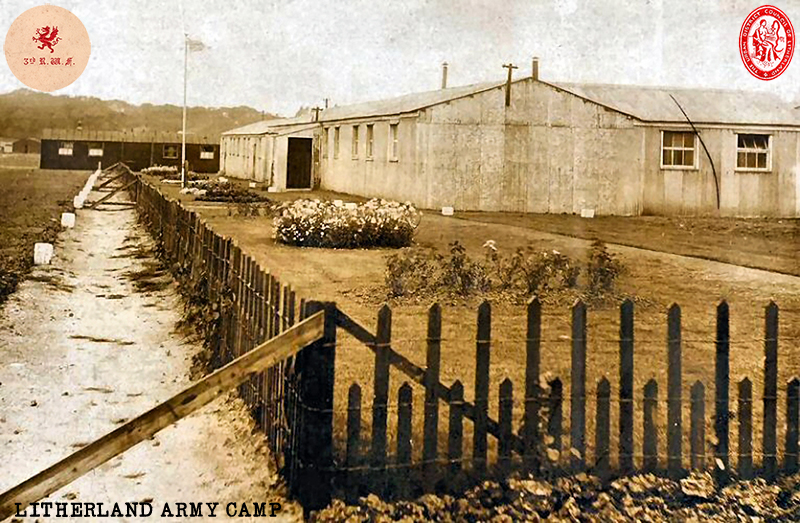LITHERLAND
AT WAR
1914—1918
1914—1918
Litherland Army Camp
1915— 1920
1915— 1920
 |
The
3rd (Reserve) Battalion, Royal Welsh Fusiliers were based at Litherland.
The battalion were part of the Mersey Defence Force which also supplied
troops to guard the docks. The main function of the camp was to
train new recruits for the frontline battalions of the Royal Welsh
Fusiliers and to 'harden up' returning soldiers from wound/sick
leave for frontline duty. Troops from the camp also guarded the Munitions Factory and Bryant & May's Matchworks. The camp was roughly sited in an area between Wilson's Lane/Boundary Road and Church/Sefton Roads. The area from St Wilfred's School to Church Road was also part of the camp. This part of the camp was still being used by the Army Cadets into the 1960s |
 |
|---|

|
Literary personalities
who spent time at Litherland Army Camp |
||
|---|---|---|
| Siegfried Sassoon 1886-1967  |
Robert Graves 1895-1985  |
Ellis
Humphrey Evans (Hedd Wyn) 1887-1917  |
|
HOW
TO DIE
Dark clouds are smouldering into red While down the craters morning burns. The dying soldier shifts his head To watch the glory that returns; He lifts his fingers toward the skies Where holy brightness breaks in flame; Radiance reflected in his eyes, And on his lips a whispered name You'd think, to hear some people talk, That lads go West with sobs and curses, And sullen faces white as chalk, Hankering for wreaths and tombs and hearses. But they've been taught the way to do it Like Christian soldiers; not with haste And shuddering groans; but passing through it With due regard for decent taste. by Siegfried Sassoon Note: The officers at Litherland Army Camp were made honorary members of the Formby Golf Club. On one visit to Formby, Sassoon threw his Military Cross into the Mersey in protest of the war.  |
GOOD-BYE
TO ALL THAT
1916:
Page 169AN AUTOBIOGRAPHY Robert Graves (excerpts) The camp was only separated by the bombing-field from Brotherton's (Lanstar site) where a specially sensitive explosive for detonators was made. The munition makers had permanently yellow faces and hands and drew appropriately high wages. Attwater used to argue at mess sometimes what would happen if Brotherton's blew up. Most of us held that the shock would immediately kill all the three thousand men of the camp besides destroying Litherland and a large part of Bootle. He maintained that the very closeness of the camp would save it; that the vibrations would go over and strike a big munition camp about a mile away and set that off. One Sunday afternoon Attwater limped out of the mess and suddenly saw smoke rising from Brotherton's. Part of the factory was on fire. The camp fire-brigade was immediately bugled for and managed to put the fire out before it reached a vital spot. So the argument was never decided. 1917: Page 217 The president of the Osborne medical board had been right: I should not have been back on duty. The training at the Third Battalion camp was intensive, and being given command of a trained-men company I did not get enough rest. I realised how bad my nerves were when one day, marching through the streets of Litherland on a battalion route-march, I saw three workmen in gas-masks beside an open man-hole, bending over a corpse which had just been hauled up from a sewer. His clothes were sodden and stinking; face and hands, yellow. Waste chemicals from the munitions factory had got into the sewage system and gassed him when he went down to inspect. My company did not pause in its march, and I had only a glimpse of the group; but it reminded me so strongly of France that, but for the band-music, I should have fainted. (Graves was gassed and wounded in France) Note: The incident above happened in July 1917 in Bridge Road with two men being killed, the council surveyor Arthur Carter and a workman. |
HEDD
WYN
Hedd Wyn, born Ellis Humphrey Evans, was a sheep farmer turned poet-soldier who was killed during the First World War. Evans - who chose Hedd Wyn ('white peace') as his pen name - was born in Penlan, Trawsfynydd the eldest of eleven children, and lived for much of his life at Yr Ysgwrn, a hill farm east of Trawsfynydd. He began writing Welsh-language poetry at an early age; when aged 24 he was awarded a chair at Bala; others followed at Llanuwchllyn, Pwllheli and Pontardawe (the latter in 1915 with the First World War underway). Wynn sat out the war for three years as a sheep farmer until he was called up for military service in 1917. Following a spell of training in Litherland Private Evans was despatched for active service in Flanders and found himself stationed with his regiment at the notorious Pilckem Ridge immediately prior to the opening of the Passchendaele offensive (3rd Ypres). It was at Pilckem Ridge that Wyn was killed during fighting in August 1917. Buried initially on the battlefield, his body was subsequently moved to Artillery Wood cemetery following the armistice. September that year brought a posthumous award of the chair at the National Eisteddfod of Wales for his verse poem Yr Arwr ('The Hero'). Wyn had written the poem while serving in Flanders and completed it shortly before his death under the nom-de-plume of 'fleur-de-lis'. The chair itself was draped in black in memorial of Wyn following the announcement of his win and revelation of the author's actual identity. Note: Hedd Wyn is buried in Artillery Wood Cemetery, Ieper, West-Vlaanderen, Belgium Killed in Action 4th August 1917 |